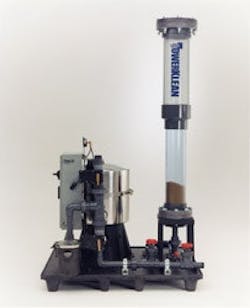Water Cooling Towers Operate at Better Efficiency, Lower Maintenance Costs
For industrial or commercial companies and municipalities that use water towers, cooling systems, or filtering systems, scale (along with pollutants like algae, heavy metals, debris, etc.) can cause problems for the system and destroy its efficiency.
TowerKlean LLC searched out a scale-reducing media to make its cooling water-processing equipment work better for their customers.
TowerKlean’s primary customer base includes industrial plastic-injection molding companies that use water-cooling towers to supply water used for cooling molds in the injection molding process. But other customers such as municipalities and a host of many others also purchase the equipment for treating water.
“In typical cooling tower applications, there’s heat involved that is warming the water, and heating water, combined with concentration of hardness through evaporation precipitates the scale forming compounds as filterable solids” said Harry Manvel, sales manager for TowerKlean. “It coats pipes, heat exchangers and has a big effect on efficiency. What our system does is eliminates the creation of scale and it also removes any existing scale from a process water system.” The system was actually developed by a company called Innovative Water Technologies in 1995.
IWT was in the high-volume water-treatment systems business. They discovered a process media solution produced by KDF Fluid Treatment, Inc. and realized it was a great application for water tower treatment.
Providing protection
As water evaporates, the dissolved minerals will concentrate. These minerals and contaminants will eventually reach a concentration where they will precipitate as scale and interfere with the performance of both the tower and the cooling system itself.
Typically, chemicals were added to the water to inhibit the formation of scale, control algae and bacterial, and provide corrosion protection. KDF Process Media eliminates the need for any chemicals.
“Basically, with the reaction of the KDF media , we are able to modify the crystal structure of the scale compound (calcium carbonate), changing it from calcite to aragonite,” remarked Manvel. “In this modified form, aragonite is suspended in the water until removed by the filter. As the filter backwashes, the scale is literally flushed down the drain.
To turn the scale into aragonite and eliminate it, IWT developed a patented fluidized bed using a column of water concept, which is the heart of the TowerKlean Cooling Water Treatment System along with the KDF 55 media . This column allows water to flow up through it, and fluidizes the media.
An important feature of this up-flow design is the graduated two diameter clear column where the lower pipe is smaller in diameter than the top pipe. When the water travels upward, the upper and wider pipe reduces the velocity and pressure of the water and allows the media to fluidize. It’s also a self-regulating design that won’t allow the media to migrate out of the column chamber.
“Without fluidizing this media, our system would work for about a week, then scale would form in the reaction column and turn it into cement. Also the “KDF media is a combination of copper and zinc. The zinc is given off over time and is the key to the system. It modifies the scale, and a very thin coating of it ends up on the pipe walls (plastic or metal), which serves as a corrosion inhibitor,” said Manvel. “It also raises the pH level of the water system to one that is not conducive to corrosion. It actually gives off a low-voltage current because of the reaction of the copper, zinc, and water and develops an electrical field that kills algae. KDF’s filter media can’t be washed and reused, because it changes shape and eventually wears out, but lasts for a long time...and it’s environmentally recyclable. After its use, it can be sold for its scrap metal value.”
Manvel added, “It eliminates virtually all chemical treatments. Most of the other systems out there do part of the job, but not all of it. But you have to have several different devices to take care of corrosion inhibiting, scale removal, and biological treatment. These are basically three areas that you have to have separate systems for, but TowerKlean takes care of all of them.
Karen Manvel, owner of TowerKlean remarked, “By eliminating chemicals, companies can free up storage space, and not have to worry about health and safety issues relating to using harsh chemicals. So our system has a lot of advantages.”
System design
A strainer is the first part of the TowerKlean system, which filters out any large debris. Next, a filter is used that has a single grade of sand to remove smaller debris, silt and turbidity.
The following step includes one or more graduated columns, depending on water volume, containing the
